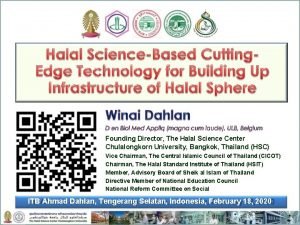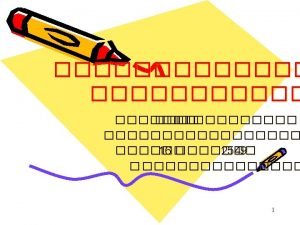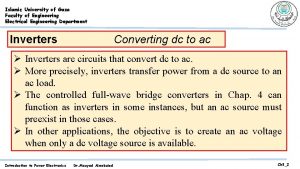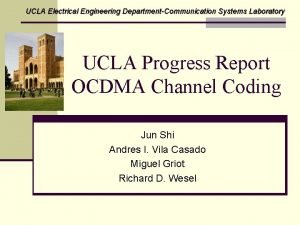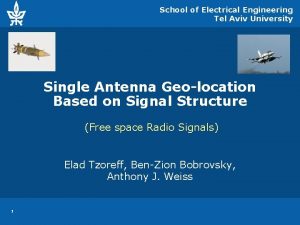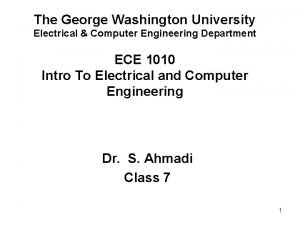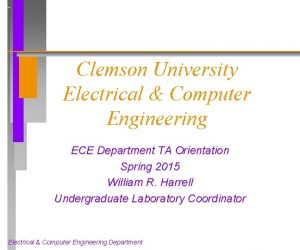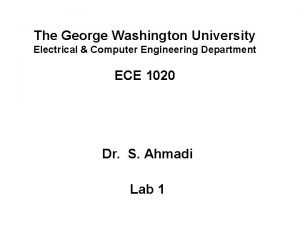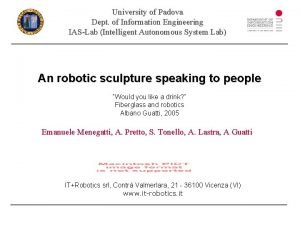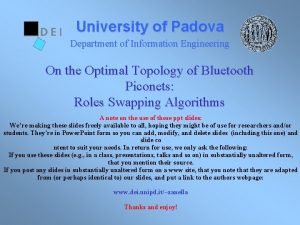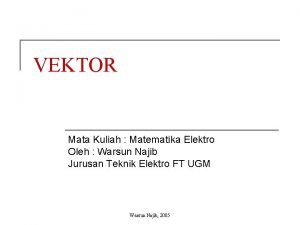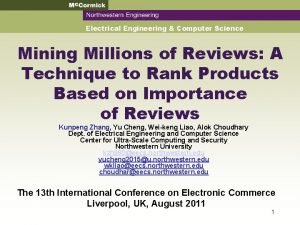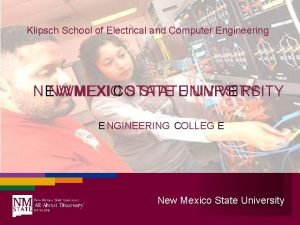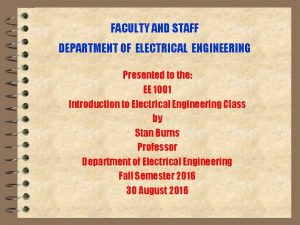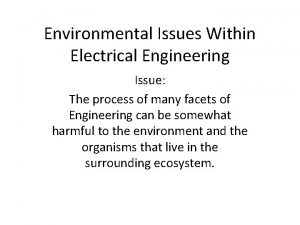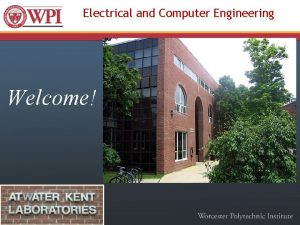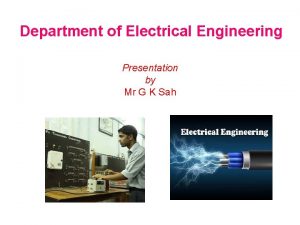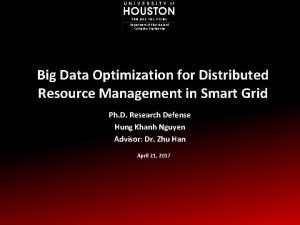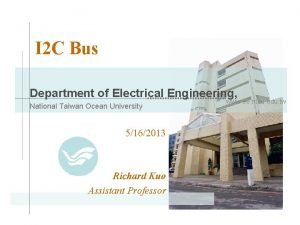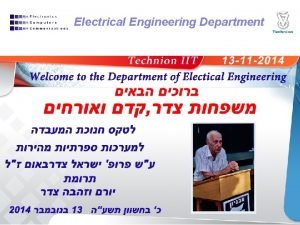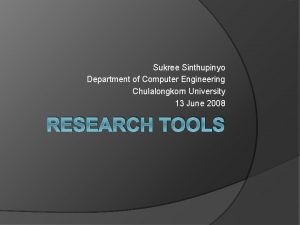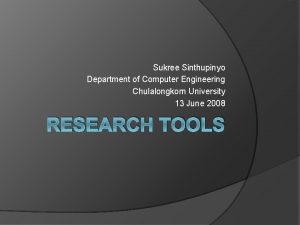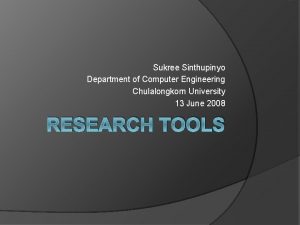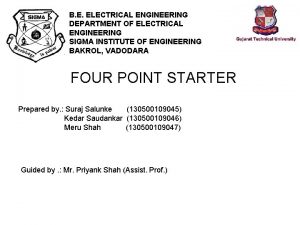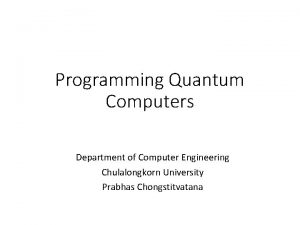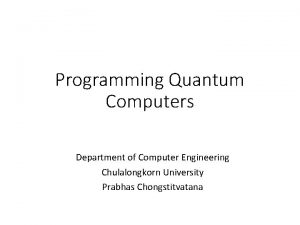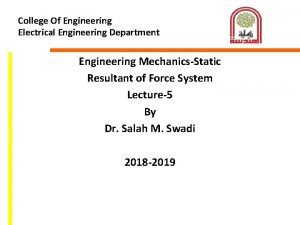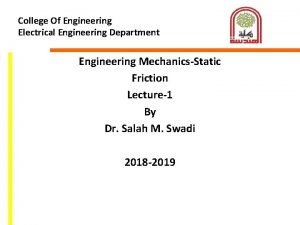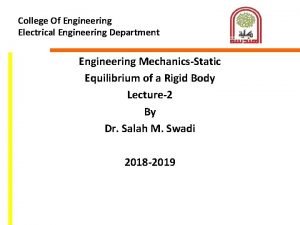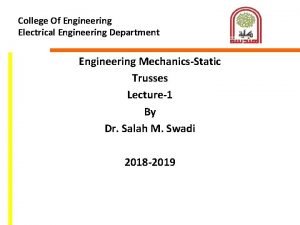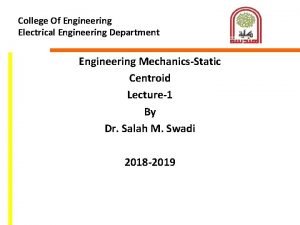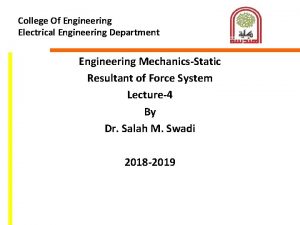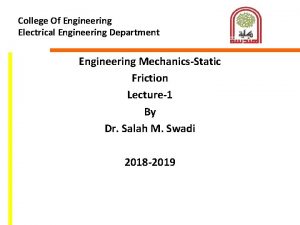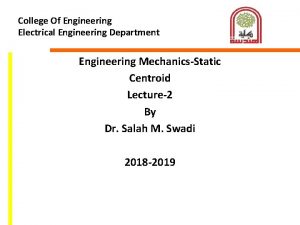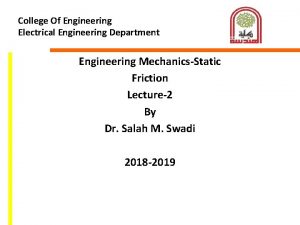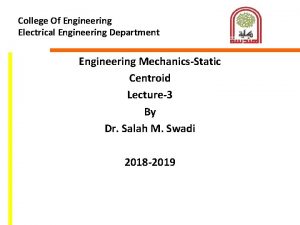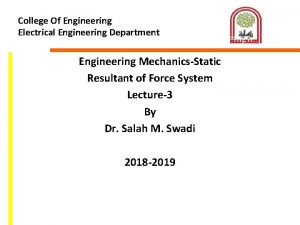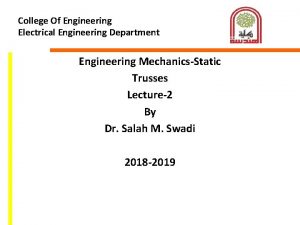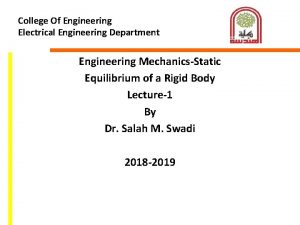Chulalongkorn University Department of Electrical Engineering The Impacts






![1. Smart Grid SG challenges: Deliver both energy and information [2] 7 1. Smart Grid SG challenges: Deliver both energy and information [2] 7](https://slidetodoc.com/presentation_image_h/f7c5a6056598e359a54b3528610decef/image-7.jpg)
![1. Smart Grid 8 Source: European Smartgrids Technology Platform [3] 1. Smart Grid 8 Source: European Smartgrids Technology Platform [3]](https://slidetodoc.com/presentation_image_h/f7c5a6056598e359a54b3528610decef/image-8.jpg)
![1. Smart Grid 9 Source: European Smartgrids Technology Platform [3] 1. Smart Grid 9 Source: European Smartgrids Technology Platform [3]](https://slidetodoc.com/presentation_image_h/f7c5a6056598e359a54b3528610decef/image-9.jpg)

![2. Smart Grid Technologies • Technology layers of smart grid [1] Human brain Nerves 2. Smart Grid Technologies • Technology layers of smart grid [1] Human brain Nerves](https://slidetodoc.com/presentation_image_h/f7c5a6056598e359a54b3528610decef/image-11.jpg)



![2. Smart Grid Technologies Zig. Bee Home Area Network (HAN) [2] 15 2. Smart Grid Technologies Zig. Bee Home Area Network (HAN) [2] 15](https://slidetodoc.com/presentation_image_h/f7c5a6056598e359a54b3528610decef/image-15.jpg)


![2. Smart Grid Technologies • An example of smart meter from Freescale [5] 18 2. Smart Grid Technologies • An example of smart meter from Freescale [5] 18](https://slidetodoc.com/presentation_image_h/f7c5a6056598e359a54b3528610decef/image-18.jpg)

![3. Examples and Impacts on PQ • Application examples are [1]: 1) Equipment monitoring 3. Examples and Impacts on PQ • Application examples are [1]: 1) Equipment monitoring](https://slidetodoc.com/presentation_image_h/f7c5a6056598e359a54b3528610decef/image-20.jpg)







![References [1] E. Santacana, G. Rackliffe, L. Tang and X. Feng, “Getting Smart, ” References [1] E. Santacana, G. Rackliffe, L. Tang and X. Feng, “Getting Smart, ”](https://slidetodoc.com/presentation_image_h/f7c5a6056598e359a54b3528610decef/image-28.jpg)

- Slides: 29

Chulalongkorn University Department of Electrical Engineering The Impacts of Smart Grid Technologies on Power Quality Asst. Prof. Thavatchai Tayjasanant, Ph. D. (Thavatchai. T@chula. ac. th or taytaycu@gmail. com) Sept 27 -28, 2010 @ Grand Sukhumvit Hotel, Bangkok, Thailand

Presentation Outline Smart Grid Technologies Examples and Impacts on PQ Conclusions 2

1. Smart Grid • Smart Grid (SG) - Other names: Intelligent grid, Modern grid and Future grid - Various definitions [1] USA: self-healing, active participation by consumers, operate resiliently, provide quality power, accommodate all generation and storage options, optimize asset utilization and operate efficiency. 3

1. Smart Grid The Department of Energy’s (DOE) Smart Grid Task Force defines 7 characteristics of smart grid: 1. Enable active participation by consumers 2. Accommodate all generation and storage options 3. Enable new products, services, and markets 4. Provide power quality for the range of needs in a digital economy 5. Optimize asset utilization and operating efficiency 6. Anticipate and respond to system disturbances in a self-healing manner 7. Operate resiliently against physical and cyber attacks, and natural 4 disasters

1. Smart Grid Europe (European Commission report): flexible, accessible, reliable an economical. China: An electricity transmission and distribution system that incorporates elements of traditional and cutting-edge power engineering, sophisticated sensing and monitoring technology, information technology, and communications to provide better grid performance and to support a wide range of additional services to consumers. 5

1. Smart Grid • Main challenges of power grids – Deguration uncertain power flow scenarios – Increasing penetration of renewable energy uncertainty in power supply – Require a supply of high quality and availability – Need to achieve sustainable growth and minimize environment impact by energy conservation increase energy efficiency, reduce peak demand maximize the use of renewable energy 6
![1 Smart Grid SG challenges Deliver both energy and information 2 7 1. Smart Grid SG challenges: Deliver both energy and information [2] 7](https://slidetodoc.com/presentation_image_h/f7c5a6056598e359a54b3528610decef/image-7.jpg)
1. Smart Grid SG challenges: Deliver both energy and information [2] 7
![1 Smart Grid 8 Source European Smartgrids Technology Platform 3 1. Smart Grid 8 Source: European Smartgrids Technology Platform [3]](https://slidetodoc.com/presentation_image_h/f7c5a6056598e359a54b3528610decef/image-8.jpg)
1. Smart Grid 8 Source: European Smartgrids Technology Platform [3]
![1 Smart Grid 9 Source European Smartgrids Technology Platform 3 1. Smart Grid 9 Source: European Smartgrids Technology Platform [3]](https://slidetodoc.com/presentation_image_h/f7c5a6056598e359a54b3528610decef/image-9.jpg)
1. Smart Grid 9 Source: European Smartgrids Technology Platform [3]

1. Smart Grid • Power grid has to be more active and dynamic in its configuration and its operational condition. • Smart grid technologies are required to answer these challenges. 10
![2 Smart Grid Technologies Technology layers of smart grid 1 Human brain Nerves 2. Smart Grid Technologies • Technology layers of smart grid [1] Human brain Nerves](https://slidetodoc.com/presentation_image_h/f7c5a6056598e359a54b3528610decef/image-11.jpg)
2. Smart Grid Technologies • Technology layers of smart grid [1] Human brain Nerves that transmit perception and motor signals Body’s sensory and motor nerves Body’s muscles 11

2. Smart Grid Technologies • Smartness of the smart grid lies in the decision intelligence layer (L 4). • Advanced algorithms such as – – Events and faults diagnosis Load balancing and management Adaptive protection Energy management systems are required for this layer. 12

2. Smart Grid Technologies • Grid data need to be transferred from the connected devices to the controllers that process the information and transmit the control directives back to the devices. • This task can be performed by communication layer (L 3) with the help from advanced information and communication technology (ICT). 13

2. Smart Grid Technologies • One example of ICT is from Zig. Bee which was launched in 2002 to develop open standard for wireless sensor networks. • Home Area Network (HAN) Home automation piece • Zig. Bee Smart Energy was released in 2008 with following benefits: metering, pricing, support for distributed generation, demand response and load control, security level options for data and so on [2]. 14
![2 Smart Grid Technologies Zig Bee Home Area Network HAN 2 15 2. Smart Grid Technologies Zig. Bee Home Area Network (HAN) [2] 15](https://slidetodoc.com/presentation_image_h/f7c5a6056598e359a54b3528610decef/image-15.jpg)
2. Smart Grid Technologies Zig. Bee Home Area Network (HAN) [2] 15

2. Smart Grid Technologies • Advanced metering is one part of the sensor/actuator layer (L 2). • Two-way communication is needed. • An example is Advanced Metering Infrastructure (AMI): Full measurement and collection system that includes meters at the customer site, communication networks between the customer and a service provider, such as an electric, gas, or water utility, and data reception and management systems that make the information available to the service provider [4]. 16

2. Smart Grid Technologies • Advanced Metering Infrastructure (AMI) Customers are equipped with smart meters which transmit data via communication network to AMI host managed by MDMS. Two-way communication between meter and utility 17
![2 Smart Grid Technologies An example of smart meter from Freescale 5 18 2. Smart Grid Technologies • An example of smart meter from Freescale [5] 18](https://slidetodoc.com/presentation_image_h/f7c5a6056598e359a54b3528610decef/image-18.jpg)
2. Smart Grid Technologies • An example of smart meter from Freescale [5] 18

2. Smart Grid Technologies • Technologies for the physical layer (L 1): – Solid-state technology (e. g. Si. C IGBT [6]) – Power electronics–based building blocks (e. g. HVDC) – Superconducting materials (e. g. superconducting cables) – New battery storage technologies 19
![3 Examples and Impacts on PQ Application examples are 1 1 Equipment monitoring 3. Examples and Impacts on PQ • Application examples are [1]: 1) Equipment monitoring](https://slidetodoc.com/presentation_image_h/f7c5a6056598e359a54b3528610decef/image-20.jpg)
3. Examples and Impacts on PQ • Application examples are [1]: 1) Equipment monitoring and diagnostic systems (asset management) 2) Wide-area monitoring, protection, and control 3) Voltage and var optimization (energy efficiency and demand reduction) 4) Intelligent load balancing and feeder reconfiguration (energy efficiency) 5) Self-setting and adaptive relays (protection) 20

3. Examples and Impacts on PQ • Application examples (cont. ): 6) Online system event identification and alarming (safety and reliability) 7) Voltage collapse vulnerability detection (security) 8) Autonomous outage detection and restoration (self-healing) 9) Dynamic power compensation, using energy storage and voltage source inverters (efficiency and stability) 21

3. Examples and Impacts on PQ • Major PQ issues 1) Harmonics and Interharmonics 2) Voltage dips (sags) and Interruptions 3) Voltage fluctuation and Flicker 4) Voltage transients 5) Voltage unbalance (imbalance) 6) Power-frequency variation 22

3. Examples and Impacts on PQ • Impacts on PQ 1) PQ monitoring will be more informative and reliable provided from advanced communication technologies. System characteristics can be fully analyzed from AMI data. However, large amount of information has to be processed. 23

3. Examples and Impacts on PQ 2) Outage Management System (OMS) + Distribution Management System (DMS) Distribution Network Management System (NMS), e. g. switch order management and operation. 3) On-line disturbance detection, classification, location and event notification can be achieved through advanced smart meters. Proper measures can be taken effectively. 24

3. Examples and Impacts on PQ 4) In order to accommodate many distributed energy sources (DERs), the system protection has to be adaptive. This modification will affect voltage dips or sags issue. In addition, harmonic and voltage fluctuation levels can be increased from these DERs and other interconnection issues need more attention. 25

3. Examples and Impacts on PQ 5) For self-healing purpose, the network configuration requires changing and switching, this results in higher number of switching transients in the system. 6) Better control of the power system (stability, security, reliability, optimization and load balancing) and energy management (efficiency) can be achieved through smart grid technologies. These benefits increase PQ of the system. 26

4. Conclusions • Smart grid technology is a collection of existing and emerging standards-based, interoperable technologies working together. • Technology layers of smart grid can be divided into 4 layers: 1) Power transport/ storage, 2) Sensor, 3) Communication and 4) Decision intelligence. • Various impacts on PQ from smart grid technologies need to be investigated. 27
![References 1 E Santacana G Rackliffe L Tang and X Feng Getting Smart References [1] E. Santacana, G. Rackliffe, L. Tang and X. Feng, “Getting Smart, ”](https://slidetodoc.com/presentation_image_h/f7c5a6056598e359a54b3528610decef/image-28.jpg)
References [1] E. Santacana, G. Rackliffe, L. Tang and X. Feng, “Getting Smart, ” IEEE Power & Energy magazine, March/April 2010. [2] B. Heile, “Smart grids for green communication, ” IEEE Wireless communications, June 2010. [3] European Smart. Grids Technology Platform, European Commission, 2006. [4] Advanced Metering Infrastructure (AMI), EPRI, Feb 2007 [5] Freescale semiconductor (http: //www. freescale. com) [6] J. Wang, A. Q. Huang, W. Sung, Y. Liu, and B. J. Baliga, “Smart Grid Technologies, ” IEEE Industrial Electronics Magazine, June 2009. 28

Thank You End of the presentation 29
 Faculty of communication arts chulalongkorn university
Faculty of communication arts chulalongkorn university Halal science center chulalongkorn university
Halal science center chulalongkorn university Chulalongkorn university
Chulalongkorn university Electrical engineering department
Electrical engineering department Tum department of electrical and computer engineering
Tum department of electrical and computer engineering Ucla electrical engineering
Ucla electrical engineering Tel aviv university electrical engineering
Tel aviv university electrical engineering University of belgrade school of electrical engineering
University of belgrade school of electrical engineering George washington university electrical engineering
George washington university electrical engineering Clemson electrical engineering
Clemson electrical engineering Tel aviv university electrical engineering
Tel aviv university electrical engineering George washington university electrical engineering
George washington university electrical engineering Department of information engineering university of padova
Department of information engineering university of padova Department of information engineering university of padova
Department of information engineering university of padova University of sargodha engineering department
University of sargodha engineering department Vector electrical engineering
Vector electrical engineering Northwestern computer science department
Northwestern computer science department Klipsch school of electrical and computer engineering
Klipsch school of electrical and computer engineering Electrical engineering umd
Electrical engineering umd Purpose of estimating and costing in electrical engineering
Purpose of estimating and costing in electrical engineering Electrical engineering environmental issues
Electrical engineering environmental issues Umassd electrical engineering flowchart
Umassd electrical engineering flowchart Electrical engineering presentation
Electrical engineering presentation Electrical engineering kfupm
Electrical engineering kfupm Big data in electrical engineering
Big data in electrical engineering Chapter 11 electrical engineering
Chapter 11 electrical engineering Analogy between electric and magnetic circuits
Analogy between electric and magnetic circuits Electrical engineering notation
Electrical engineering notation Ntou ee
Ntou ee The world says hello
The world says hello

